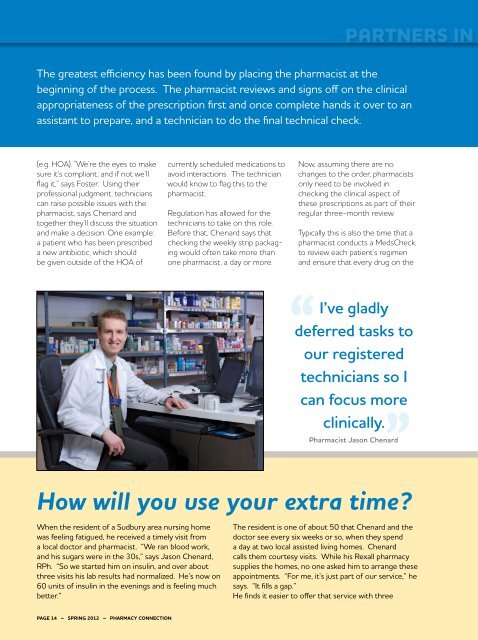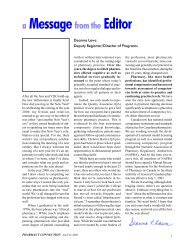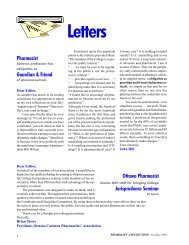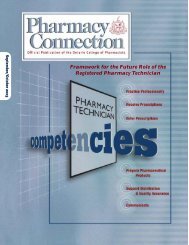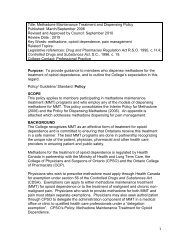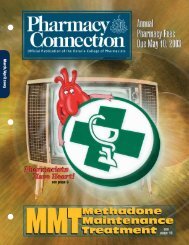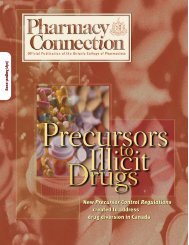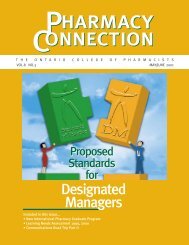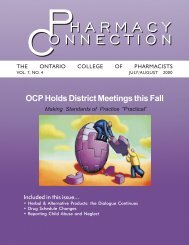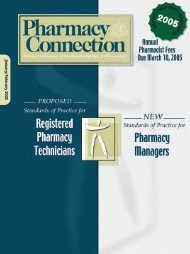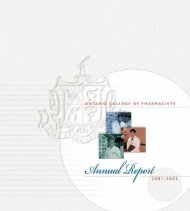Spring 2012 ⢠volume 19 number 2 - Ontario College of Pharmacists
Spring 2012 ⢠volume 19 number 2 - Ontario College of Pharmacists
Spring 2012 ⢠volume 19 number 2 - Ontario College of Pharmacists
You also want an ePaper? Increase the reach of your titles
YUMPU automatically turns print PDFs into web optimized ePapers that Google loves.
PartnerS In<br />
The greatest efficiency has been found by placing the pharmacist at the<br />
beginning <strong>of</strong> the process. The pharmacist reviews and signs <strong>of</strong>f on the clinical<br />
appropriateness <strong>of</strong> the prescription first and once complete hands it over to an<br />
assistant to prepare, and a technician to do the final technical check.<br />
(e.g. HOA). “We’re the eyes to make<br />
sure it’s compliant, and if not we’ll<br />
flag it,” says Foster. Using their<br />
pr<strong>of</strong>essional judgment, technicians<br />
can raise possible issues with the<br />
pharmacist, says Chenard and<br />
together they’ll discuss the situation<br />
and make a decision. One example:<br />
a patient who has been prescribed<br />
a new antibiotic, which should<br />
be given outside <strong>of</strong> the HOA <strong>of</strong><br />
currently scheduled medications to<br />
avoid interactions. The technician<br />
would know to flag this to the<br />
pharmacist.<br />
Regulation has allowed for the<br />
technicians to take on this role.<br />
Before that, Chenard says that<br />
checking the weekly strip packaging<br />
would <strong>of</strong>ten take more than<br />
one pharmacist, a day or more.<br />
Now, assuming there are no<br />
changes to the order, pharmacists<br />
only need to be involved in<br />
checking the clinical aspect <strong>of</strong><br />
these prescriptions as part <strong>of</strong> their<br />
regular three-month review.<br />
Typically this is also the time that a<br />
pharmacist conducts a MedsCheck,<br />
to review each patient’s regimen<br />
and ensure that every drug on the<br />
I’ve gladly<br />
deferred tasks to<br />
our registered<br />
technicians so I<br />
can focus more<br />
clinically.<br />
Pharmacist Jason Chenard<br />
How will you use your extra time?<br />
When the resident <strong>of</strong> a Sudbury area nursing home<br />
was feeling fatigued, he received a timely visit from<br />
a local doctor and pharmacist. “We ran blood work,<br />
and his sugars were in the 30s,” says Jason Chenard,<br />
RPh. “So we started him on insulin, and over about<br />
three visits his lab results had normalized. He’s now on<br />
60 units <strong>of</strong> insulin in the evenings and is feeling much<br />
better.”<br />
The resident is one <strong>of</strong> about 50 that Chenard and the<br />
doctor see every six weeks or so, when they spend<br />
a day at two local assisted living homes. Chenard<br />
calls them courtesy visits. While his Rexall pharmacy<br />
supplies the homes, no one asked him to arrange these<br />
appointments. “For me, it’s just part <strong>of</strong> our service,” he<br />
says. “It fills a gap.”<br />
He finds it easier to <strong>of</strong>fer that service with three<br />
PAGE 14 ~ SPRING <strong>2012</strong> ~ PHARMACY CONNECTION


